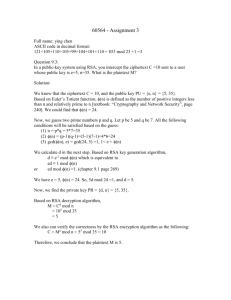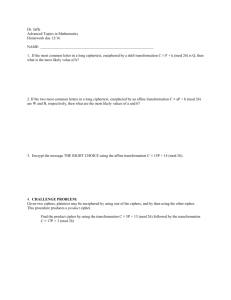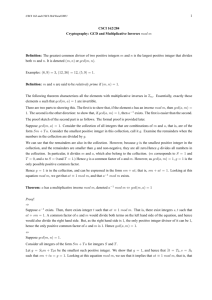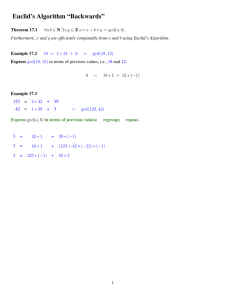Solution - the GMU ECE Department
advertisement
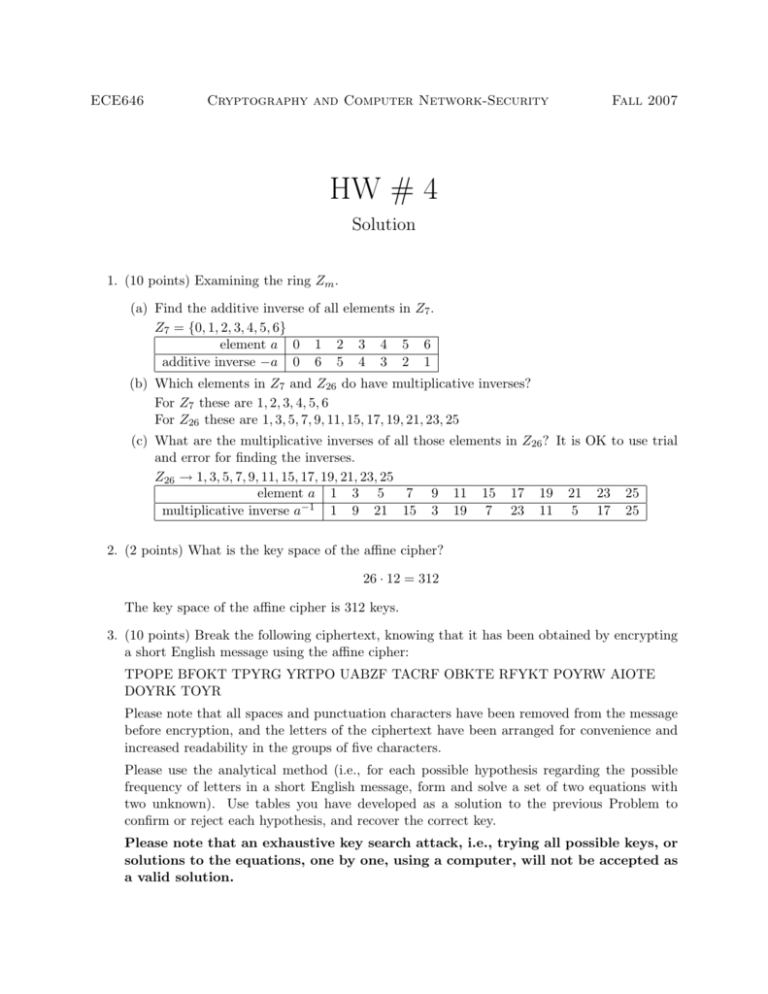
ECE646
Cryptography and Computer Network-Security
Fall 2007
HW # 4
Solution
1. (10 points) Examining the ring Zm .
(a) Find the additive inverse of all elements in Z7 .
Z7 = {0, 1, 2, 3, 4, 5, 6}
element a 0 1 2 3 4 5 6
additive inverse −a 0 6 5 4 3 2 1
(b) Which elements in Z7 and Z26 do have multiplicative inverses?
For Z7 these are 1, 2, 3, 4, 5, 6
For Z26 these are 1, 3, 5, 7, 9, 11, 15, 17, 19, 21, 23, 25
(c) What are the multiplicative inverses of all those elements in Z26 ? It is OK to use trial
and error for finding the inverses.
Z26 → 1, 3, 5, 7, 9, 11, 15, 17, 19, 21, 23, 25
element a 1 3 5
7 9 11 15 17 19 21 23 25
multiplicative inverse a−1 1 9 21 15 3 19 7 23 11 5 17 25
2. (2 points) What is the key space of the affine cipher?
26 · 12 = 312
The key space of the affine cipher is 312 keys.
3. (10 points) Break the following ciphertext, knowing that it has been obtained by encrypting
a short English message using the affine cipher:
TPOPE BFOKT TPYRG YRTPO UABZF TACRF OBKTE RFYKT POYRW AIOTE
DOYRK TOYR
Please note that all spaces and punctuation characters have been removed from the message
before encryption, and the letters of the ciphertext have been arranged for convenience and
increased readability in the groups of five characters.
Please use the analytical method (i.e., for each possible hypothesis regarding the possible
frequency of letters in a short English message, form and solve a set of two equations with
two unknown). Use tables you have developed as a solution to the previous Problem to
confirm or reject each hypothesis, and recover the correct key.
Please note that an exhaustive key search attack, i.e., trying all possible keys, or
solutions to the equations, one by one, using a computer, will not be accepted as
a valid solution.
The most common letter in a long English text is ‘E’ followed by ‘T’. In this short ciphertext
the most frequent letter is ‘T’ followed by ‘O’. This would yield the following mapping:
E→T
T→O
However, in this short text it turns out that ‘T’ is the most frequent letter followed by ‘E’
which yields this mapping:
E→O
T→T
or in numbers
4 → 14
19 → 19
This results in two equations for the affice cipher with two unknowns:
4 · k1 + k2 ≡ 14 (mod 26)
19 · k1 + k2 ≡ 19
(mod 26)
subtracting the first equation from the second:
15 · k1 ≡ 5 (mod 26),
We need the multiplicative inverse of 15 mod 26 which we get from the table from question
1c) as 7.
k1 = 5 · 7 ≡ 9 (mod 26)
Now we enter k1 into one of the two equations and get the value for k2 .
4 · 9 + k2 ≡ 14 (mod 26)
k2 = 14 − 36 ≡ 4
(mod 26)
4. (8 points) Using the basic form of Euclid’s algorithm, compute the greatest common divisor
of the following numbers. Write down every step.
(a) 4891 and 2847
4891 = 1 · 2847 + 2044
2847 = 1 · 2044 + 803
2044 = 2 · 803 + 438
803 = 1 · 438 + 365
438 = 1 · 365 + 73
365 = 5 · 73 + 0
gcd(4891, 2847) = 73
(b) 5457 and 1823
5457 = 2 · 1823 + 1811
1823 = 1 · 1811 + 12
1811 = 150 · 12 + 11
12 = 1 · 11 + 1
11 = 11 · 1 + 0
gcd(5457, 1823) = 1
5. (10 points) Using the extended Euclidean algorithm to compute the inverse of elements α in
Zm . Write down every step.
(a) a = 5, m = 34
s · 34 + t · 5 = gcd(34, 5)
34 = 6 · 5 + 4 q = 6 s = 1 − 6 · 0 = 1
5=1·4+1
q = 1 s = 0 − 1 · 1 = −1
gcd(34, 5) = 1, t = 7 ≡ 5−1 mod 34
t = 0 − 6 · 1 = −6
t = 1 − 1 · −6 = 7
(b) a = 34, m = 283
s · 283 + t · 34 = gcd(283, 34)
283 = 8 · 34 + 11 q = 8 s = 1 − 8 · 0 = 1
34 = 3 · 11 + 1
q = 3 s = 0 − 3 · 1 = −3
gcd(283, 34) = 1, t = 25 ≡ 34−1 mod 283
t = 0 − 8 · 1 = −8
t = 1 − 3 · −8 = 25







